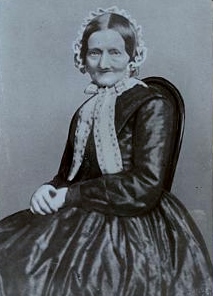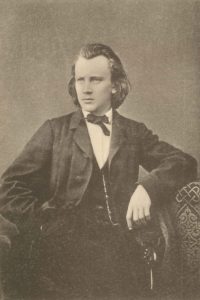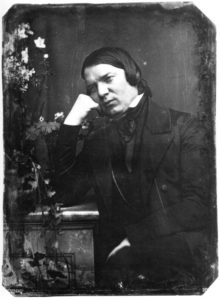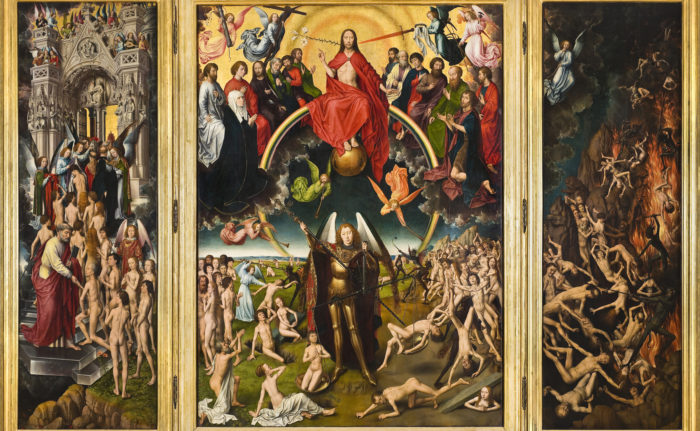On February 2, 1865, Johannes Brahms received an urgent telegram from his brother Fritz: “If you want to see our mother once again, come immediately.” At age 76 their mother, Christiane Brahms, had had a stroke. Brahms hastened to her from Vienna, but she had already passed away by the time he arrived in Hamburg. Christiane Brahms’ life had not been an easy one; she had begun work as a seamstress at 12, and only married Brahms’ father Johan Jakob (a poor musician seventeen years her junior) at 41. After 34 years, the marriage deteriorated, and her husband left her in 1864. Brahms, who loved both his parents dearly, had tried to reconcile them to no avail. The loss affected the composer profoundly, and almost immediately he began work on A German Requiem.

Though the death of his mother was the immediate catalyst for the work, it is possible that the idea for it originated after the death of his mentor Robert Schumann nine years earlier. It was Schumann who had first made the young, unknown Brahms famous by declaring him Beethoven’s heir in a widely read music publication. In the years since, however, Brahms had struggled to convince the musical world that he was worthy of Schumann’s prophecy. A German Requiem would at last convince many that Schumann was right.
A (Non)Traditional Requiem
The requiem mass was a venerable musical genre by the time Brahms began to compose his, but Brahms’ requiem would be unlike any other. Instead of setting the traditional Catholic, Latin text used by Mozart Berlioz, and countless others, Brahms created his own highly personal version from excerpts of the Lutheran Bible and apocrypha. Though this gives Brahms’ requiem a uniquely Protestant character that reflects his Northern German upbringing, sectarian dogmas could not have been farther from his mind when composing it.

Indeed, after the conductor of the Bremen premiere expressed concern that the requiem omitted any reference to Jesus, Brahms responded by writing that “As far as the text is concerned, I will confess that I would very gladly omit the ‘German’ as well, and simply put ‘of Mankind,’ also quite deliberately and consciously do without passages such as John 3:16.”
John 3:16 is perhaps the most famous Christian bible verse: “For God so loved the world, that he gave his only begotten Son, that whosoever believeth in him should not perish, but have everlasting life.” At the same time, Brahms did set explicitly Christian excerpts from the first letter of Paul to the Corinthians, which describes the miraculous resurrection of the dead during the apocalypse. His letter to the conductor explained: “On the other hand, however, I did accept many a thing because I am a musician, because I was making use of it, because I cannot challenge or strike out the text of my revered bards, not even a ‘from henceforth.’”
Brahms was an intensely private man; he left no written credo, and we will never know exactly what his religious beliefs were. He was confirmed in the Lutheran church as a youth and knew the bible thoroughly; it would remain a key source of inspiration for him throughout his life. At the same time he was profoundly interested in the latest scientific developments of his day, and it is safe to say that he did not interpret the bible as a literal account of history. One reason for his omissions might be his openness to people of other religions. One of his closest lifelong friends, the violinist Joseph Joachim, was Jewish, and Brahms never exhibited the anti-Semitism common in many of his contemporaries.
Whatever the nature of his own beliefs, many have noted that unlike traditional requiems which offer prayers for the souls of the dead, Brahms’ German Requiem is more concerned with offering comfort to the living. His remark that “I would very gladly omit the ‘German’ as well, and simply put ‘of Mankind,’” suggests that he wished to offer this solace to all listeners, regardless of their own religious beliefs or backgrounds.

Nevertheless, the clergy of the Bremen cathedral insisted on presenting more doctrinally sound music after the Requiem was performed there for the first time, including “I know that my redeemer liveth” and the Hallelujah Chorus from Handel’s Messiah.
Musically, the requiem was a major milestone in Brahms’ career. Indeed, it would be the longest and most grandly scored piece he would ever write. More notable than its dimensions, however, is the way it engages with musical tradition. One perceptive contemporary noted that “The music of the future, for others a vogue, is for Brahms already a music of the past.” Few of Brahms’ works display their influences as openly as the German Requiem does; numerous passages clearly evoke the music of Schumann, Beethoven and Bach. At the same time, every measure is unmistakably Brahms.
Throughout the nineteenth century there was an increasing awareness of the value of the past that resulted in the creation of new artistic canons. There was also a growing belief in the need for contemporary artists to study the past to learn how to create new works that might equal the old. The idea of “classical music”—a body of great masterpieces by composers of the past—was just coming into its own, and few composers embraced the past with the fervor that Brahms did.
Even as a young man, Brahms had displayed a marked interest in music history, and over the course of his life he would amass an impressive collection of scores, sketches and original manuscripts by composers from the Renaissance through his own day, studying them in order to learn their inner workings. He acutely felt the pressure of being compared to composers he venerated like Bach, Mozart and Beethoven, and struggled to compose music that would live up to their example and satisfy his own exacting standards. With the requiem, the result was an innovative new work that emanated the grandeur, authority and solemnity of music that had withstood the test of time even though it was completely new.
The Music
The piece opens with a warm, Brahmsian timbre of divisi violas and cellos that lead to the chorus’s first statement: “Blessed are those who mourn, for they shall be comforted.”
The first movement then unfolds as a gentle, lyrical expression of consolation. The frequent unaccompanied choral passages often reveal Brahms’ knowledge of renaissance choral music.

The second begins with what has been described as an unusual funeral march in ¾ time. This theme was salvaged from the unfinished symphony Brahms tried to complete in the wake of Schumann’s madness and death (other material from the symphony was reworked as his Piano Concerto No. 1). The choice of triple meter for a march may be an allusion to the triple meter march of the League of David against the Philistines that Schumann wrote to conclude his Carnival; Schumann’s victory march here becomes and expression of grief. This uncanny melody underpins the chorus’s grim meditation on the vanity of all worldly things as it sings “all flesh is as grass.” This soon grows into a monumental statement that unleashes the full power of the assembled forces; perhaps this is Brahms’ musical response to the disintegration of Schumann’s genius.
After a contrasting episode that implores us to “be patient, dear brothers, until the coming of the Lord,” the march returns, but as it dies away it leads to a defiant statement: “Yet the word of the Lord stands for evermore.” The following music takes on a heroic tone reminiscent of the “Ode to Joy” finale of Beethoven’s Ninth Symphony, particularly when the chorus sings the word “Freude”—“Joy.”
The third movement moves into the realm of Schumannesque lieder with a solo for bass-baritone, who asks the Lord to “teach me that I must have an end, and that my life has a purpose,” words then echoed by the chorus. The music grows more intense as the chorus asks, “Now, Lord, how shall I find comfort?” until the tension is resolved in a Bach-inspired pedal fugue, a kaleidoscopic musical texture that occurs above one long, sustained bass note. The solidity and constancy of that bass pedal (a term borrowed from organ music, in which bass notes are played with foot pedals) seems to provide an answer to the question as the chorus sings, “The righteous souls are in the hand of God, and no torment touches them.”
The fourth movement provides respite from the somber thoughts of the previous movements as the chorus years for heaven in waltz-time, singing “How lovely are your dwellings.” The waltz-like melody alternates with more complex contrapuntal episodes. This movement’s untroubled sweetness and beauty have made it a popular and frequently excerpted part of the requiem.
The fifth movement, a song for soprano, chorus and orchestra, is one of the most personal and moving. The soprano solo has a maternal character that Brahms surely associated with his own mother. She sings “You now have sorrow, but I will see you again,” to which the chorus replies, “Thee I will comfort as one whom a mother comforts.” Interestingly, Brahms only composed and integrated this movement into the requiem after the Bremen premiere. Perhaps the reticent Brahms only realized its necessity as the heart of the work after hearing the rest of it performed.

The sixth movement balances the drama of the second with an apocalyptic vision in which the chorus plays the role of souls awaiting resurrection. A mysterious introduction featuring the bass-baritone leads to a powerful chorus: “For the trumpet shall sound, and the dead shall be raised incorruptible.” The movement ends in triumph as the chorus sings “Death, where is your sting? Hell, where is your victory?” and a grand fugue praising God.
The final movement brings the requiem to a tranquil conclusion. The music that set the opening words “Blessed are those who mourn” returns at the end, this time to the words “Blessed are the dead who die in the Lord.”
—Calvin Dotsey
Don’t miss Brahms’ German Requiem May 4, 5 & 6! Get tickets and more information at houstonsymphony.org.



